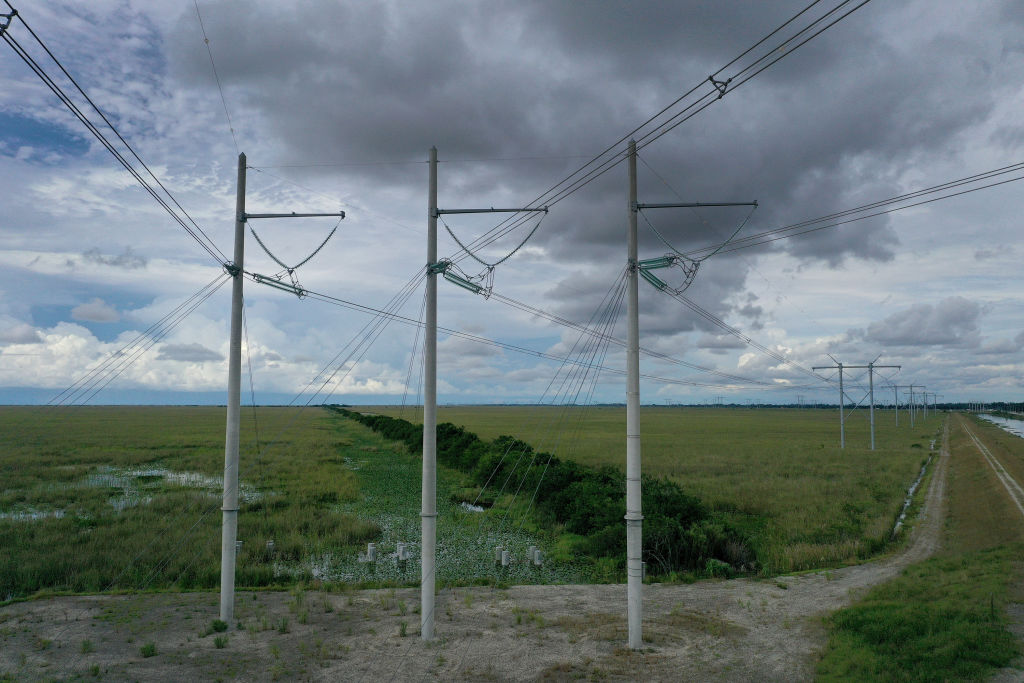Regulators and policymakers are frantically scrambling to solve profound threats to the US electric grid. Affordable, accessible energy is the foundation of economic growth and social stability, yet both are under strain. The overburdened and undermaintained existing transmission system is approaching a catastrophic failure – and renewable energy manufacturing is only making things worse.
A Fast-Growing Electricity Crisis
 The unfolding crisis is exacerbated by gargantuan electricity demands across the land, particularly for data centers, AI facilities, and factories to manufacture EVs, solar panels, heat pumps, and related components. Additionally, grid capacity for EV charging stations, and the additional drawdown of electricity to power heat pumps, induction stoves, and other gadgetry once fueled by other sources, will exponentially amplify energy needs in tandem with the massive electricity demands of AI and data centers.
The unfolding crisis is exacerbated by gargantuan electricity demands across the land, particularly for data centers, AI facilities, and factories to manufacture EVs, solar panels, heat pumps, and related components. Additionally, grid capacity for EV charging stations, and the additional drawdown of electricity to power heat pumps, induction stoves, and other gadgetry once fueled by other sources, will exponentially amplify energy needs in tandem with the massive electricity demands of AI and data centers.
The silver lining may be that this epic planning and policy failure will expose the many frauds perpetrated on Americans in the name of lucrative renewable energy subsidization by the government. The oxymoronically monitored “zero-emissions energy” is plainly a misnomer – solar panels and EVs create massive amounts of carbon dioxide pollution in their manufacture, especially in coal-burning China, but they also bring chemical pollution, gaping mining operations, and disposal impacts.
The demand for more power is rising faster than Biden-era inflation. Georgia increased its projections for electricity needs for the next decade by a factor of 17. Arizona Public Service claims it will be out of transmission capacity before the end of this decade. Northern Virginia and Texas both require the equivalent of multiple new nuclear power plants to meet the needs of planned data centers in those states. Companies seeking to secure power supplies have sparked a tripling of land prices in some areas of Chicago and a quadrupling in parts of Columbus, Ohio. The North American Electric Reliability Corp. (NERC) projected US demand for electricity has “skyrocketed from 221,000 gigawatt hours last year to a staggering 564,000 gigawatt hours this year.”
Puzzled Regulator Head-Scratching
This rapidly unfolding crisis has regulators and renewable energy proponents scratching their heads in puzzlement. This is particularly apparent in states in crisis, and Jason Shaw, chairman of the Georgia Public Service Commission, worries the situation could be developing at an irreversible rate. “It makes you scratch your head and wonder how we ended up in this situation,” Shaw said. “How were the projections that far off? This has created a challenge like we have never seen before.”
Some companies seek to go “off the grid,” constructing AI or data centers in remote deserts with independent energy resources. Massive facilities located in uninhabited areas where vast solar arrays can tap sunlight and feed new facilities are also under consideration. However, this still requires the manufacture of the arrays and the consequent drain on existing energy and other resources.
How “Renewables” Destroyed the Grid
The problems with America’s electric grid are much worse than merely increased demand – renewable energy boondoggles have “fragilized” the grid for years by superimposing “renewable” fantasies on economic realities. The problem with government intrusion into free markets is that the technocrats are divorced from reality and need not be concerned with the consequences of market-damaging policies.
Meredith Angwin’s timely 2020 book, Shorting the Grid: the Hidden Fragility of Our Electric Grid, raised the alarm about the gradual destruction of US electricity distribution inflicted by ill-advised policies. Government-imposed edicts such as renewable mandates and fictitious carbon credits undermine grid maintenance and true energy production.
Angwin documents that the laws of physics that constrain utility companies do not apply to technological fantasists. Power generation and demand must always be balanced, but policy constraints issued by Regional Transmission Organizations (RTOs) instead control the grid, ensuring that “the least-reliable power plants are the most likely to make a profit”:
“…in many cases, renewables don’t have to make any money by actually selling their energy to the grid. They make money by selling RECs (Renewable Energy Certificates) and by receiving production tax credits. Renewables can pay the grid to take their power (negative pricing) and still come out ahead financially.
“It is easy to dismiss New England’s problems as New England’s problems. But they are the direct result of overbuilding renewables, closing nuclear and coal plants, moving to natural gas to back up the renewables, and not building new gas pipelines. This is a scenario for grid fragility.”
Angwin explains that RTOs do not consider utilities’ capital expenses (maintenance costs) in the electricity bidding process. In traditional, vertically integrated grids, “the utility could fold most of its maintenance costs into the rates. In general, plants in RTO areas defer maintenance more than plants in traditionally organized areas.” RTOs also guarantee higher rates for consumers, have eliminated responsibility for grid reliability, and result in “negative pricing” advantages to renewable-credit subsidized power plants.
Transmission Stalls and Power Storage
 This may explain why the US new transmission line installation has stalled from 4,000 miles added in 2013 to approximately 1,000 new miles a year since. The government has created disincentives to maintain or build out transmission lines and power plants while rewarding those who trade in intangible carbon credits that have nothing to do with actual electricity generation. According to Angwin, “Transmission costs changed from 6% of total cost in 2008 to 24% in 2017.” No wonder electricity rates continue to rise sharply even as gasoline and other fuel prices decline.
This may explain why the US new transmission line installation has stalled from 4,000 miles added in 2013 to approximately 1,000 new miles a year since. The government has created disincentives to maintain or build out transmission lines and power plants while rewarding those who trade in intangible carbon credits that have nothing to do with actual electricity generation. According to Angwin, “Transmission costs changed from 6% of total cost in 2008 to 24% in 2017.” No wonder electricity rates continue to rise sharply even as gasoline and other fuel prices decline.
Angwin also calls attention to the lurking elephant in the renewable living room: grid power storage. The electrification of fleets of buses and trucks, and calls to exponentially increase EVs and solar panels, result in increased electricity demand but also storage. Says Angwin:
“People who are sure-in-their-hearts that renewables can do everything usually assume that the storage problem is solved somehow. It isn’t. And such people rarely acknowledge that any storage solution will be subject to the materials-availability issue and the round-trip-power-loss issue. Moreover, to store electricity and use it later, we will have to make more electricity than if we used it immediately.”
Despite all the best-laid fantasies of renewable energy proponents, reality is sinking in. Like synthetic meats that cannot be produced, the promises of a brave new solar world ensure a national electricity generation crisis with no quick fix. The lucrative renewable energy industry will continue to propagandize the world-saving benefits of its dysfunctional products. “Carbon-free energy” remains a myth, and so does the fantasy that the US electric grid can withstand such abuse.




